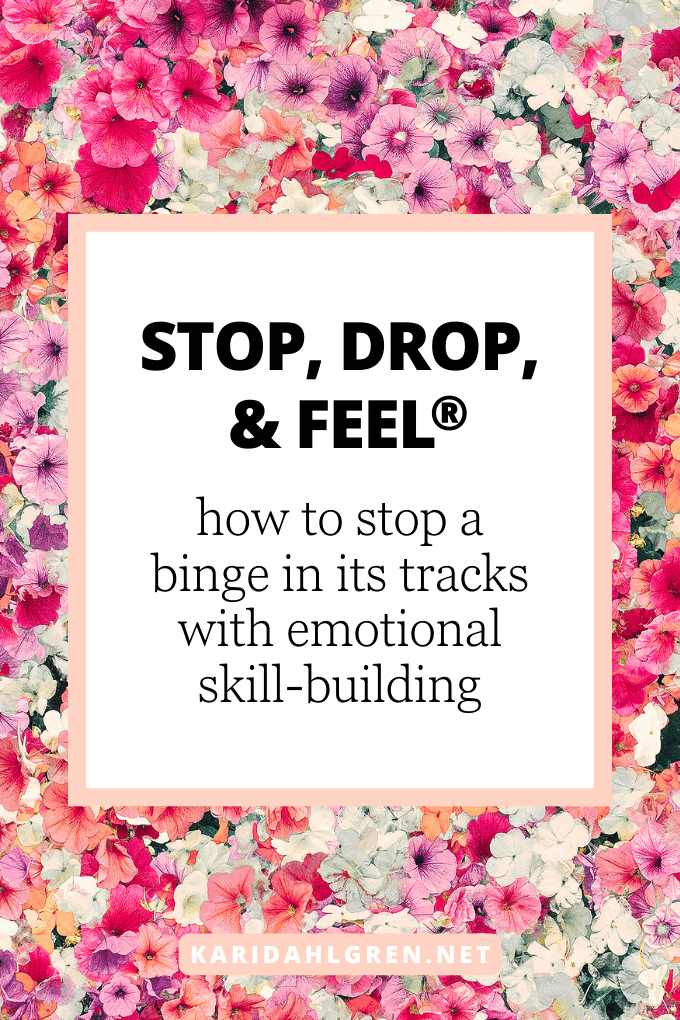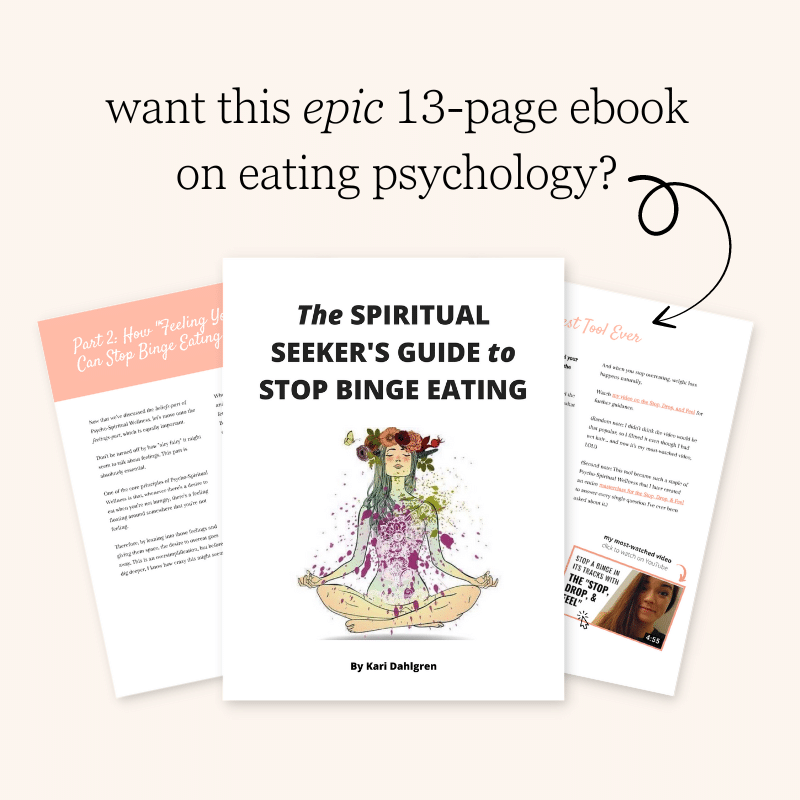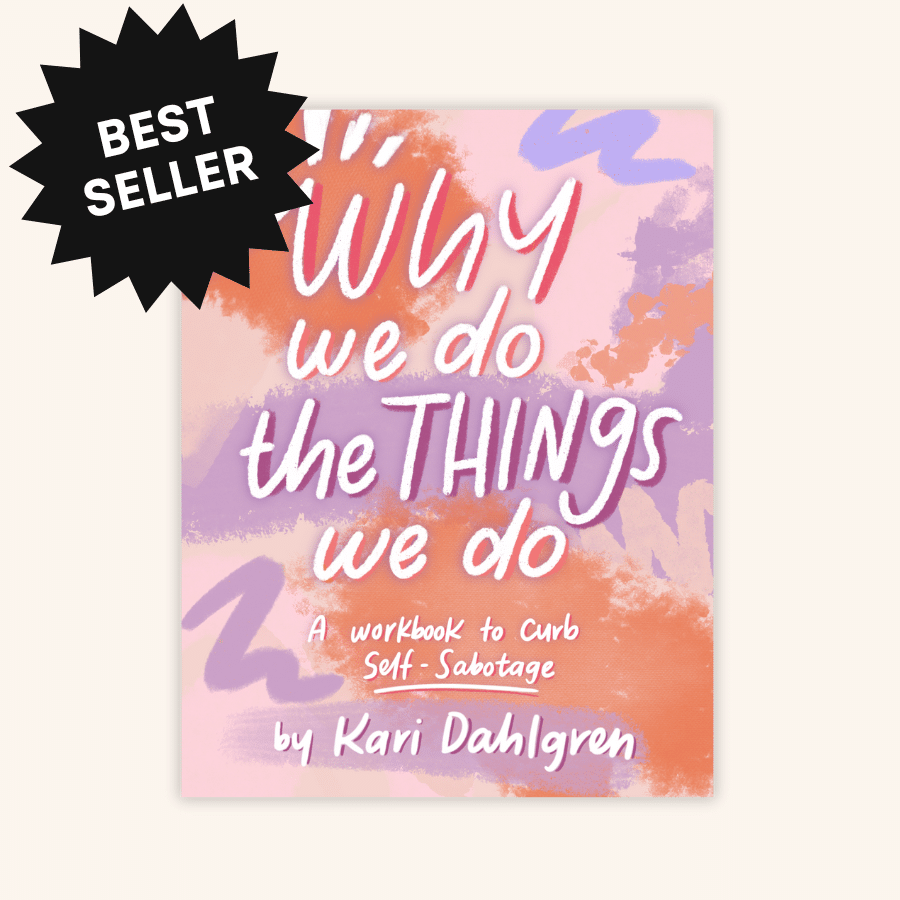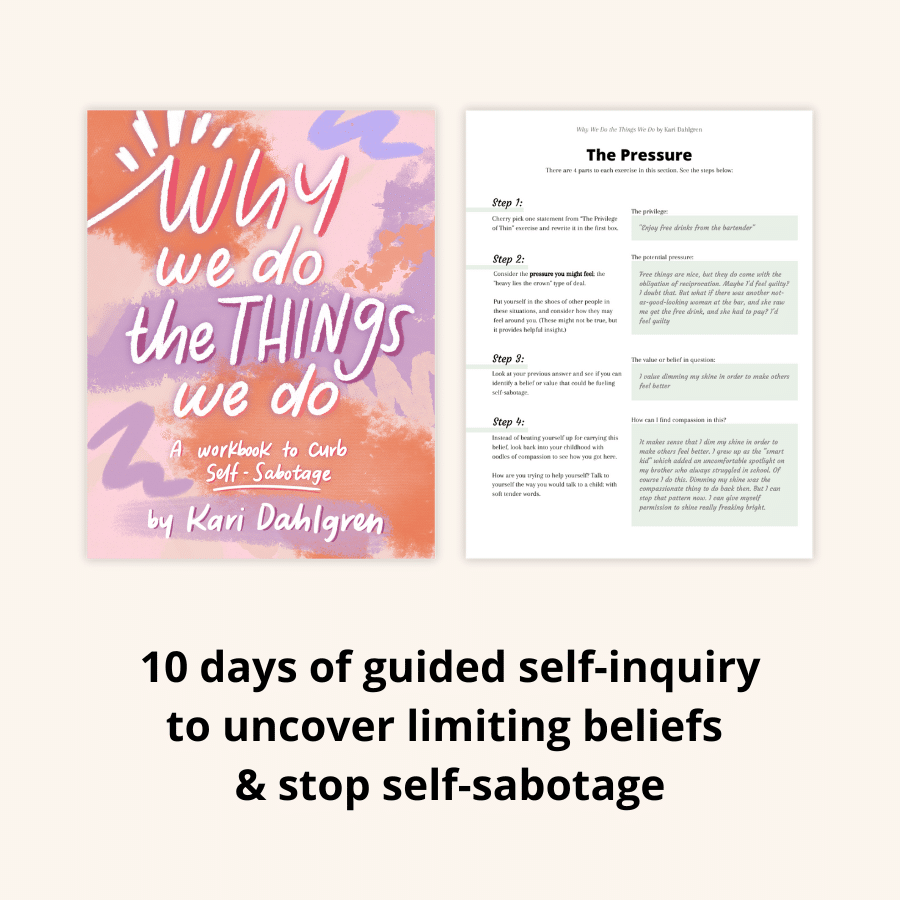
The Stop, Drop, & Feel® is the lynchpin of how I stopped binge eating without resorting to ineffective food rules like “no sweets after dinner” or “no eating after 8p.m.” Perhaps the most frustrating part of navigating compulsive eating is that trying to feel in control often results in feeling the opposite.
If you’ve ever experienced a moment where you don’t want to eat beyond fullness but compulsively do it anyway, the Stop, Drop, & Feel can help reduce and minimize those frustrating events. Keep in mind that occasional instances of overeating or turning to food for comfort are normal. No one can completely eliminate moments of eating beyond fullness while still living a vibrant and full life.
But when those moments occur regularly and cause anguish, self-criticism, and self-doubt, tools that enhance emotional self-regulation can help, and that’s what the Stop, Drop, & Feel is all about. You’re about to learn exactly how to practice this tool to stop patterns of compulsive eating, along with the science that supports its efficacy.
How the Stop, Drop, & Feel Works
The Stop, Drop, & Feel is a tool for navigating out-of-control eating by developing emotional tolerance, the ability to withstand edginess without resorting to maladaptive coping mechanisms like turning to food for comfort. By enhancing emotional self-regulation skills, you can learn how to stop a binge in its tracks—and if you can’t get there at first, you can get there with practice.
Here’s a video that explains the ins and outs of the Stop, Drop, & Feel, along with common mistakes to avoid:

There are three steps to using the Stop, Drop, & Feel—with ‘stop’ being the hardest part. After all, the nature of compulsive eating is that it feels out-of-control, and I have plenty of tips to help make the ‘stop’ more accessible. It’s all about unpacking the psychology behind overeating to learn how to stop a binge in its tracks without resorting to restrictive dieting practices.
Here are the steps for practicing the Stop, Drop, & Feel:
1. Stop
Whenever you feel the desire to reach for food without hunger—whether it’s reaching for the second half of your plate after you’re already full, or opting for dessert despite feeling stuffed from dinner—pause. Promise yourself that you can eat the food that you’re craving after the Stop, Drop, & Feel is over. This promise is critical and un-skippable for the SDF to work.
Without this promise, the Stop, Drop, & Feel simply becomes another form of restriction, which otherwise triggers the restrict-binge cycle. You don’t want to feel restricted or deprived!
This promise is what helps make the ‘stop’ more accessible. Often, compulsive eating is fueled by the desire to rebel against food rules. When there are no food rules to rebel against, this tool becomes a little more accessible.
Note that I said “a little more” accessible. That’s because the Stop, Drop, & Feel is not an easy tool to use. That said, it’s often enough to push you just over the edge of accessibility (meaning, just barely into the realm of feeling not-so-out-of-control) so that you can use the willpower that you already have to practice this all-important tool.
Also, it’s worth mentioning that the Stop, Drop, & Feel is similar to but distinctly different from urge surfing, a Cognitive-Behavioral Therapy tool that involves “surfing” the wave of an urge until it dissipates. In the context of compulsive eating, expecting the urge to go away diminishes the element of permission, so don’t skip that step. The promise is un-skippable.
2. Drop
Once you identify the urge to eat beyond fullness and promise yourself that you can eat the food you’re craving once the Stop, Drop, & Feel is over, go to a separate room, sit or lie down, set a timer for two minutes, and drop in. Get curious about what you’re feeling.
3. Feel
Then, for just two minutes, surrender to the present moment. Focus on curiosity. What are you feeling? Then, try not to resist any edgy emotions that come up, and don’t try to feel better. The SDF isn’t about feeling better; it’s just about feeling. When you practice holding space for uncomfortable emotions, you develop what I like to call emotional tolerance (referred to as distress tolerance in clinical literature).
Emotional tolerance is the ability to withstand edginess without getting swept away by it. When you can tolerate any emotion no matter how uncomfortable, edgy, or crawl-out-of-your-skin-cringe-worthy it might be, you’ll feel less inclined to overeat.
When the timer goes off, ask yourself if you still want to eat. If you do, eat. You must honor the element of permission, otherwise you risk triggering the restrict-binge cycle. Most of the time, once you develop the skill of emotional tolerance, you won’t want to eat beyond fullness.
As you can see, there are many layers to unpack when it comes to emotional self-regulation skills and how they affect our relationship with food. For anyone that wants to dive deeper, I created a robust online course called the Stop, Drop, & Feel Masterclass to help you feel more supported and confident in the journey beyond compulsive eating.
Why the Stop, Drop, & Feel Works: Exploring the Science
If you watch the video at the start of this article, you’ll learn that the first time I ever used Stop, Drop, & Feel, it began as a rather flippant thought. I was merely curious to see if there was an emotion driving my desire to reach for sugar after a meal, which I had previously dismissed as sugar addiction. To my surprise, I discovered unacknowledged tears that needed my attention, and after fully experiencing these emotions, my desire for sugar completely disappeared.
In the years following, I refined the Stop, Drop, & Feel through personal experiences and insights from my readers and coaching clients. This ongoing development was further supported by my exploration of clinical literature, which confirmed the effectiveness of emotional tolerance in curbing compulsive eating.
Here are the most noteworthy studies I’ve found:
- Distress Tolerance in Emotional Eating: A study published in the journal Eating Behaviors found that improving distress tolerance could weaken the link between poor emotional regulation and compulsive eating behaviors.[1]
- Distress Tolerance and Overeating: Research published in the journal Appetite demonstrates significant relationships between low distress tolerance and increased emotional and compulsive eating, highlighting distress tolerance as a critical target for curbing food addiction and overeating behaviors.[2]
- Emotional Regulation and Binge-Eating Disorder (BED): An investigation into emotional regulation strategies in women with BED reveals that those with BED exhibit higher levels of emotion regulation difficulties and are more likely to use maladaptive strategies like rumination and self-blame, highlighting the importance of addressing these challenges.[3]
- Emotional Regulation in Weight Management: A study published in the journal Psychology & Health found that successful weight loss is closely linked to the development of effective emotional regulation strategies, with the most successful individuals cultivating healthier emotional management techniques.[4]
- Driven Overeating After Bariatric Surgery: A comprehensive review published in the journal Frontiers in Endocrinology (Lausanne) explores how driven overeating post-bariatric surgery, influenced by emotional and reward-based eating, contributes to weight regain. It emphasizes the need for targeted strategies including acceptance, emotional regulation, and self-compassion to manage this challenge effectively.[5]
Even with a short summary, clinical studies can quickly grow dense. So, let’s boil all these studies down into their most basic essence: Uncomfortable emotions not only drive us to overeat, but the urge can feel compulsive and out-of-control. By enhancing emotional tolerance, patterns of compulsive eating are likely to diminish.
The Stop, Drop, & Feel helps with all of this—when practiced regularly. Because, just like any skill, emotional tolerance requires repetition and frequency to strengthen.
Stopping Compulsive Eating the Psycho-Spiritual Way
When I first tried the Stop, Drop, & Feel back in 2017, I had no idea that it would become the lynchpin of how I stopped compulsive eating and the framework for how I teach this methodology to others: through my philosophy, Psycho-Spiritual Wellness.
For anyone that wants to truly master this tool and feel normal around food again—not through white-knuckling restriction but through diligent and compassionate emotional skill-building—my Stop, Drop, & Feel Masterclass is the perfect next step.
If you want to dip your toes in the water before diving in, my free resources below are also a great next step.




In the last few days I have been watching your YouTube messages and reading the written articles. I have been on and off a “diet” from the age of 8, I’m now 39! I remember being chubby as a child and I always wanted to be slim. I lost 6.5 stone in my twenties and gained it back in my thirties. I honestly don’t feel like I have another diet in me. You videos and articles resonate with me, and I have been trying to eat normally for two days. It’s wierd, I’m not even sure what I want to eat, as I’m so used to planning meals around diet meals or cheat/binge eating. Thank you for giving me hope and some guidance of how to move forward. I think you are an inspiration. X
Hi Colette! I totally get you!! It can be really weird to start eating normally after years of dieting. It will take time for your brain to rewire itself and for you to rediscover the foods you actually like and dislike. I am excited for you!!! This is going to be an amazing journey 🙂
Hi Kari, thank you for taking time to write this out – it’s what I’ve been telling myself internally for a while but haven’t fully pulled to pieces yet.
I binge mostly because I never feel good enough (for various different reasons, triggers etc.) and I’ve allowed so many situations over the years to add to that pile, so it’s taking a very long time to pick through. I’ll try your method again next time I binge (I think anyone who suffers from it knows this one may not be the last one no matter how ‘together’ you seem), but just knowing people understand and want to help is help in itself, so thank you!
Ahh thank you so much for the lovely and deeply meaningful message Emma <3 I am happy to help and I wish you the best as you start practicing this method 🙂
I’m trying to talk my self off the gastric sleeve edge. I knew there was a better answer. So I keep searching for it. That’s how I found you. I’m all ears! I look forward to diving more into your message. I already know this is the answer I was looking for. Thank you.
I am so glad that you’re exploring alternative methods, especially before something as major as surgery. Thanks for the comment Beverly! Good luck with the Stop, Drop, & Feel and let me know how it goes 🙂 I am rooting for you!
Hi Kari
I’m 47 years old and have always been a binge eater, last year when I had to have a full hysterectomy, it induced surgical menopause I can honestly say I’m completely out of control with my eating, I know no diet can fix me and after watching your video I realize I have to fix my relationship with food. I look forward to hearing more from you. Thank you
Hi Kelly! I hope you are healing well and I am glad that this post resonated. I would love to hear how things go!
How do you stop drop and feel at work? I work in a fast pace, stressful, nursing environment and I rush around for hours, no time to stop or think, then eat like crazy – shoveling (healthy) food in my mouth – knowing I wont get to eat for a while. Then later in the evening (I work 3 – 11) I’m so stressed out, tired and hangry I start binging cookies, chips. It’s a never ending cycle. 🙁
Wow Sandi, that sounds like a very stressful and hectic work day. I am sorry you have to contend with so much! I hope you like your job and get a sense of satisfaction from it – otherwise it might be worth making a career move down the line. To answer your question – I wonder if you can manage to SDF in the bathroom? I know it’s awkward and less than ideal, but it’s what I recommend for people who have demanding lives with no real place to take breaks.
What about binge eating because you just never feel full? I have been dealing with that for as long as I can remember! It starts when I put anything in my mouth. Nothing satisfies my hunger. As I said, I never feel full and can eat (I try really hard not to) until I’m in pain in my side and shoulder. I try to drink a lot so as to fill that hunger. I am diabetic too! I also have G.E.R.D, which I manage myself.
This all sounds great, but I don’t think emotions are what is triggering me. Constant hunger is. And I’m eating myself into an early grave. 🙁
Hi Rachyl, I’m sorry to hear what’s happening. It sounds frustrating. I’m here to help! I invite you to try this method, the SDF, anyway for at least 3 weeks. Although binge eating never feels like a feelings thing, you never truly know until you give it a solid try. If you watch my video, you’ll see me explain an example where, before I binged, I felt totally fine, but once I dropped in, I started sobbing. It’s kind of crazy! I know the fullness thing is confusing for you right now, but give this a try for 3 weeks and then let me know if the issue is still the same. Good luck sister!!
Always had an issue with numbing out my feelings instead of feeling them, will try to remember this for next time I reach for the sweets when I’m feeling down.
Also, just a heads up, that youtube link is broken.
Thank you for the post, nonetheless!
Hi Raphael! Thanks for the comment 🙂 I would love to know how the SDF goes next time you try it!
Same for me, I cannot stop eating at all, it’s purely physical-every. single. time. I try to eat anything with sugar or flour. I’m 59 now and it’s worse than ever. I am terrified.
Hi Mary!! I am so sorry to hear about the anxiety that you’re experiencing. I wish I knew more details so that I could be of better help! Sugar and flour are the biggies for a lot of people, often because the keto and low-carb diets are so popular right now. Feelings of deprivation are not kind to anyone. I’m happy to help if you ever want to share more. I am glad you’re here!!
Oh my gosh! Thank you for your rapid reply, you are so professional and pleasant. I really do appreciate your work. You are such an impressive and lovely young lady. Honestly, I wish you the very best and hope you make a true mark on the world (and get rich in the process).
I’d like to think my story is the same as everyone else’s but who knows? I “non-dieted” my way up to 205 pounds on my 5’3″ frame and it’s taken me decades to approach some semblance of normal appearance at 140 (still 20 pounds overweight but pass for average size). I’m ashamed to admit the drastic measures it took. Ultimately, I depend on OMAD Keto to maintain as any deviation- and I mean a single bite of processed sugar or carb-turns me into a shark in feeding frenzy. It really is terrifying that I continue this despicable behavior fully aware of the pain it brings and days of dysfunction I suffer if and when I can snap out of it. That hope to die addict behavior is disgraceful. Is Prader Willi really a thing?
I would do anything for gastric bypass or even the lap band surgery but I never qualify because I’m not fat enough. I am reluctant to spend a single dollar on yet another method to end binge eating. I’ve read every book, done therapy, every program out there-WW, OA, CEA-HOW, FA, NA, CA, MA, diet pills, potions and all of the food combinations and have come to the conclusion that I must have some form of brain damage that no amount of feeling my feelings can broach. In the meantime, with hope upon hope, I eat up every bite (pardon the pun) of information I can on the internet. My gift of desperation has brought me to you. I am grateful.
Thank you for your very valuable time.
Hi again Mary! I am so sorry to hear about the emotional distress you’re dealing with. It seems like the anxiety is really high, and understandably so! When someone feels very anxious around food, and feels overly vulnerable when giving up the food rules, it’s not the first step. The Stop, Drop, & Feel is the first step. My “advice” to you is to focus on building emotional tolerance first, and after enough time, I wonder if it will reduce some of the anxiety that is currently a barrier to entry, so to speak. I really feel for you and all the emotions you are coping with. I wish you the very best!! Keep me in the loop and let me know how it goes 🙂
My biggest problem is not binge eating anymore but grazing. How can I possibly change my mindset where I don’t think about food all the time, my next meal, what’s in the fridge or cabinet, wanting to snack when I’m not even hungry?
I think about food ALL the time!
You are not alone, Gail! So many of us, myself included, know exactly what it’s like to think about food 24/7. Have you seen my other article on how to get food of your mind? The Stop, Drop, & Feel is part of the process, but I hope it provides even more insight. Most of all, I hope it helps you feel validated in the struggle with constant thoughts about food. There are many good reasons for it, and there are just as many steps available to help reduce the pattern. Feel free to comment on the other post if you have more questions!
I want to know if you produce a paper version of your digital workbooks as I prefer paper! I’m 70 and maybe this is my last ditch attempt to curb the beast
Hi Cath! Unfortunately I do not offer a printed version of my workbook, Why We Do the Things We Do. Thanks for your interest, though! The digital version does come with a condensed, printer-friendly version, and it also works just as well to write down your answers on a separate paper or journal. I am like you and prefer paper versions myself too, but can’t afford to offer a published version just yet. Thank you!
Hi Kari. I have been signed up for your posts and emails for a few months now. Today was my first ever successful Stop Drop and Feel. I was so full of anxiety, fear, loathing for myself, inadequacy, and an intense desperation to binge. I hung on…I felt those feelings, and somehow the urge passed. I made it through the feelings. You’ve helped me do it once. Now maybe I can do it again. Thank you so much, Kari
Hi Suzi! Wow! Thank you so much for sharing this with me—it truly means the world to hear about your experience. What you’ve done is incredible. It takes so much courage to sit with those heavy feelings, and the fact that you made it through speaks volumes about your strength. It takes true grit and compassion to sit still with such heavy feelings, and I am excited to see where those qualities can take you. I hope you feel really proud of yourself!!! And I hope to hear from you again soon. 🙂